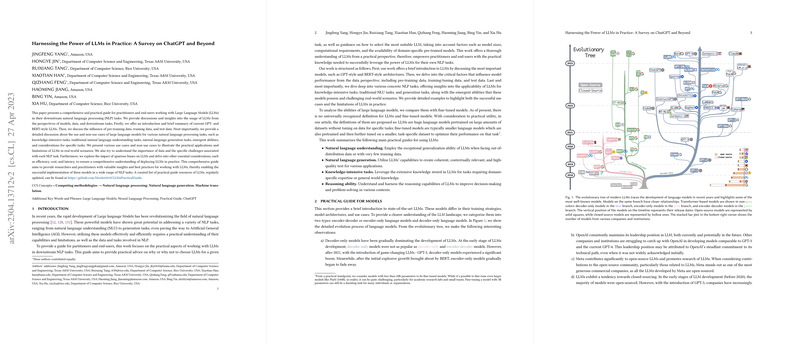Insights and Applications of LLMs: A Comprehensive Analysis
In "Harnessing the Power of LLMs in Practice: A Survey on ChatGPT and Beyond," the authors present an exhaustive examination of LLMs, with a focus on their application in NLP tasks. This paper serves as a vital resource for researchers and practitioners, offering a detailed understanding of the practical deployment of LLMs.
Overview of LLMs
The paper categorizes LLMs into two primary architectures: BERT-style (encoder-decoder or encoder-only) and GPT-style (decoder-only). Each has distinct training paradigms and use cases. Transformer-based decoder-only models, such as GPT-3 and GPT-4, are notably dominant, driven by superior few-shot and zero-shot capabilities. Encoder-decoder models like T5, on the other hand, focus on tasks requiring masked LLMing. The evolutionary trajectory of these models highlights the trend toward closed-source proprietary models, alongside substantial contributions from entities like Meta and Google in open-source projects.
Importance of Data
The role of data is central to the efficacy of LLMs. The authors emphasize the impact of pre-training, fine-tuning, and test data on model performance. They advocate for the selection of models trained on data similar to downstream tasks, noting that LLMs outperform fine-tuned models in scenarios with limited annotated data or distribution shifts. The robustness of LLMs against adversarial and out-of-distribution examples is a notable advantage over traditional fine-tuned models.
Task-Specific Analysis
- Traditional NLP Tasks: The paper highlights the superior performance of fine-tuned models on structured tasks like named entity recognition and text classification, primarily due to their tailored architecture and training data.
- Generation Tasks: LLMs demonstrate a marked advantage in open-ended text generation, summarization, and translation. The ability to generate coherent, contextually relevant text underpins their effectiveness in these areas. The paper discusses the strong performance of models like GPT-4 in diverse language generation applications.
- Knowledge-Intensive Tasks: The inherent knowledge accumulation in LLMs, thanks to vast pre-training datasets, allows them to excel in domains requiring extensive background knowledge. However, fine-tuned models can be competitive when augmented with retrieval mechanisms.
- Emergent Abilities: As models scale, unexpected capabilities such as reasoning and word manipulation emerge. These abilities are not observed in smaller models and present new opportunities for NLP task applications.
- Real-World Tasks: The adaptability of LLMs to unstructured and noisy input scenarios makes them preferable for real-world applications. Instruction tuning and human feedback mechanisms are suggested as methods to enhance alignment with user expectations.
Efficiency and Trustworthiness
While LLMs offer substantial capabilities, the paper addresses practical concerns such as computational cost, latency, and parameter-efficient tuning methods. In terms of trustworthiness, it discusses robustness, fairness, hallucinations, and safety concerns — areas requiring further research to ensure responsible deployment.
Future Directions
The paper underscores several challenges for future research, including better evaluation methodologies for real-world datasets, enhanced model alignment with human values, addressing safety concerns, and predicting performance scaling. These challenges indicate a pathway for the continued development of LLMs in both theoretical and practical dimensions.
Overall, this survey presents a comprehensive guide to the utilization of LLMs, providing essential insights and best practices for deploying these models effectively across various NLP tasks. It serves as a foundational reference for researchers seeking to explore and expand the applications of LLMs in the rapidly evolving landscape of artificial intelligence.
